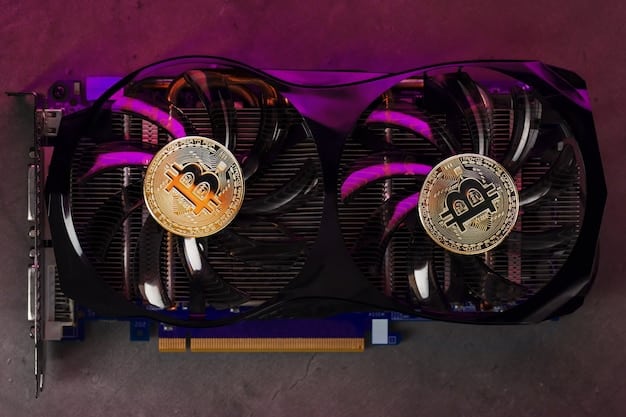Maximizing Crypto Mining Profits in the US: A 2025 Guide

Maximizing crypto mining profits in the US in 2025 requires a strategic approach, considering factors like energy costs, efficient hardware, mining pool selection, and staying updated with regulatory changes to optimize returns in the evolving cryptocurrency landscape.
Navigating the world of cryptocurrency mining can be complex, especially when aiming to maximize profits. This guide offers insights into maximizing crypto mining profits in the US: a comprehensive guide for 2025, covering essential aspects to help you succeed.
Understanding the Crypto Mining Landscape in the US
The crypto mining landscape in the US is dynamic, shaped by technological advancements, regulatory developments, and energy costs. Understanding these elements is essential for profitable mining operations.
Key Factors Influencing Mining Profitability
Mining profitability is heavily dependent on various factors. From the electricity rates you pay to the efficiency of your mining hardware, every detail contributes to your bottom line.
- Electricity Costs: The price of electricity is a significant operational expense.
- Hardware Efficiency: The more efficient your hardware, the more profitable your mining.
- Mining Pool Selection: Choosing the right mining pool can increase your chances of earning rewards.
Furthermore, environmental considerations and the evolving regulatory framework also exert considerable influence. Keeping abreast of these factors will offer a considerable edge.
Choosing the Right Mining Hardware
Selecting the appropriate hardware is a critical step in maximizing profitability. The choice impacts not only the initial investment but also the operational costs and potential returns.

ASIC Miners vs. GPU Mining
Application-Specific Integrated Circuits (ASICs) and Graphics Processing Units (GPUs) are the primary hardware options. Each has its own advantages and disadvantages.
ASICs are designed specifically for mining and offer higher hash rates, making them more efficient, but they also come with a higher upfront cost. GPUs, on the other hand, are more versatile and can be used for other applications besides mining.
- ASIC Miners: High hash rate, high upfront cost, specialized for mining.
- GPU Mining: Versatile, lower upfront cost, but less efficient for mining.
- Consider Resale Value: Some hardware retains value better, providing an option to recoup costs later.
Selecting the hardware that fits your goals and financial situation is of utmost importance for maximizing profits.
Optimizing Energy Consumption
Energy consumption is the most significant ongoing expense in crypto mining. Reducing energy costs can dramatically increase profitability.
Strategies for Lowering Electricity Costs
There are several strategies to lower electricity costs, ranging from relocating to regions with cheaper power to employing energy-efficient technologies.
One approach is to leverage renewable energy sources like solar or wind power. These options not only reduce costs but also align with environmentally sustainable practices.
- Relocate to Lower-Cost Areas: Consider regions with lower electricity rates.
- Use Renewable Energy: Solar and wind power can significantly reduce reliance on the grid.
- Energy-Efficient Hardware: Invest in miners designed for optimal power usage.
Exploring these options will play a major role to lowering expenses, leading to enhanced profits.
Selecting the Best Mining Pool
Joining a mining pool allows miners to combine their computational resources, increasing the likelihood of earning rewards. Choosing the right pool is important for consistent returns.
Factors to Consider When Joining a Pool
When selecting a pool, consider factors such as pool size, fee structure, payout methods, and the reputation of the pool operator.
A larger pool may offer more frequent payouts due to increased mining power, while a smaller pool might provide larger individual rewards, but with less frequency.

- Pool Size: Larger pools mean more frequent payouts.
- Fee Structure: Understand the costs associated with joining the pool.
- Payout Methods: Ensure the pool offers convenient and reliable payout options.
By carefully evaluating these factors, you can find a pool that aligns with your mining strategy and goals.
Staying Compliant with Regulations
Navigating the regulatory landscape is crucial for long-term success in crypto mining. Compliance avoids legal issues and fosters trust.
Understanding US Crypto Regulations
The US regulatory environment for cryptocurrencies is evolving, with various federal and state agencies playing a role. Stay informed about developments and seek guidance from legal professionals to steer clear of repercussions.
Engage with industry associations and attend seminars to understand your responsibilities and maintain regulatory compliance, which is key for continuing your mining operations.
- Federal Regulations: Understand how federal laws apply to crypto mining.
- State Regulations: Be aware of specific state laws regarding digital assets.
- Tax Implications: Properly report your mining income to avoid tax issues.
Adhering to regulatory guidelines ensures a sustainable and hassle-free mining operation.
Future Trends in Crypto Mining
Staying ahead of the curve is essential in the rapidly evolving world of cryptocurrency. Identifying and adapting to future trends can provide a competitive advantage.
Emerging Technologies and Strategies
Several emerging technologies and strategies are positioned to reshape the crypto mining industry, including innovations in hardware, energy efficiency, and mining algorithms.
Explore possibilities like immersion cooling, which enhances hardware performance and efficiency, and investigate new mining algorithms that could offer greater potential returns.
- Immersion Cooling: Enhances hardware performance and energy efficiency.
- New Mining Algorithms: Explore emerging cryptocurrencies and their mining algorithms.
- Decentralized Mining: Investigate decentralized mining pools and networks.
By monitoring and adopting these trends, miners can improve profitability and ensure they remain at the forefront of the industry.
| Key Point | Brief Description |
|---|---|
| ⚡️ Energy Costs | Lowering electricity costs is crucial for profitability. |
| ⚙️ Hardware Efficiency | Efficient hardware maximizes mining output. |
| 🤝 Mining Pools | Joining the right pool increases reward chances. |
| 🏛️ Regulations | Compliance ensures long-term sustainability. |
Frequently Asked Questions
▼
Profitability varies based on market conditions and hardware setup. Bitcoin remains a staple, but exploring emerging altcoins like Ethereum (post-Merge) could be lucrative.
▼
Consider relocating to areas with cheaper electricity, using renewable energy sources like solar or wind, and investing in energy-efficient mining hardware.
▼
Key factors include pool size, fee structure, payout methods, server location, and the pool’s reputation within the mining community to ensure stability.
▼
Miners should stay updated on federal and state regulations regarding cryptocurrencies, including tax implications and environmental concerns, to ensure compliance.
▼
Emerging trends include the use of immersion cooling, more efficient hardware, new mining algorithms, and the increasing adoption of decentralized mining pools.
Conclusion
Maximizing crypto mining profits in the US in 2025 requires a balanced approach that includes selecting efficient hardware, optimizing energy consumption, choosing the right mining pool, understanding and complying with regulations, and staying informed about future trends. By addressing these factors, miners can enhance their profitability and ensure long-term sustainability in an evolving industry.





